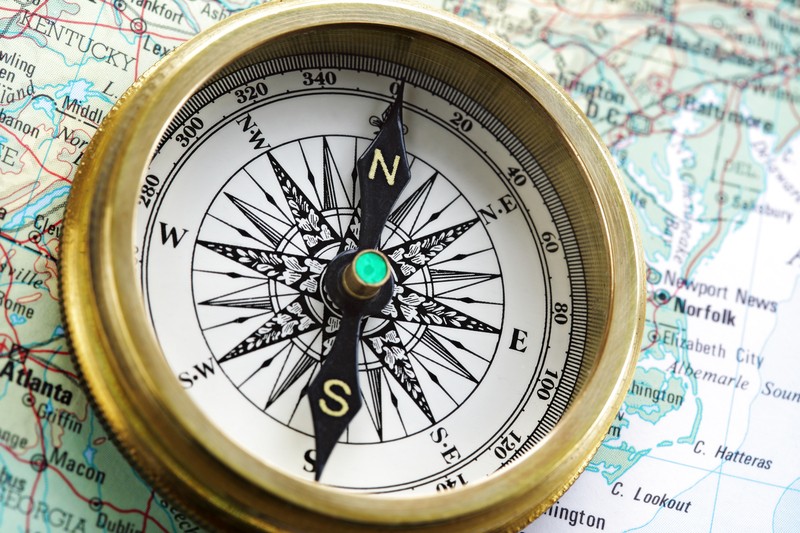In an age of GPS and cell phones, a compass might seem to be “old-fashioned.”
If those devices and tools stop working, however, a compass might be your only way to accurately get your bearings and get to safety; here is what you need to know about compasses!
Buying a Good Compass – The Basics
A floating-needle compass is a compass that uses a magnetized needle to distinguish the North from the South. The good ones are filled with a liquid that helps stabilize the needle, allowing you to get a better reading. We can break down floating-needle compasses into three main types:
Basic Compasses
For backpackers and hikers who stick to trails, these are a good and inexpensive option to consider. They contain the bare essentials, and lack some of the “extras” that you might find in advanced compasses. Compass reading with basic compasses is exactly the same as compass reading with advanced compasses (Example: Coleman Pocket Compass).
Advanced Compasses
Although you’ll pay a little more, advanced compasses come with bonus features that can make navigation easier and more accurate. These “extras” might include mirrors, magnifiers, and a few other things. If you’re someone who regularly veers off designated trails, you should consider buying an advanced compass (Example: Suunto MC-2 Compass).
Accessory Compasses
These compasses that are found on watches or keyrings. They’re typically very small, but can still point you towards the North. They are designed more for fun than anything else. By that, I mean that I wouldn’t buy an accessory compass for a deep trek into the wilderness. Instead, I might buy it for someone as a small gift (Example: Techion Key Chain Compass).
If you’re someone who always stays on the designated trail, then a basic compass might be okay for you. However, if you regularly hike away from designated trails, consider buying an advanced compass. Accessory compasses are better reserved as fun gifts or memorabilia, but that’s about all. To buy a model that will make compass navigation easier, you should understand a few more features of compasses.
Compass Features – What to Look For
Most serious backpackers use what we call an “orienting” or “base plate” compass. Here are some common features of compasses:
Magnetized Needle: As I said earlier, the RED part of the needle will be the one that faces North. I’ve never seen a compass where this wasn’t the case. Simply hold the compass level and the red needle will automatically orient itself towards the North.
Liquid-Filled Capsule: Sometimes the “housing” (where the needle sits) will be filled with a special fluid that will help stabilize the needle. This nonfreezing fluid will prevent jiggling that could throw you off. It makes compass navigation much easier.
Rotating Bezel: Also known as an “Azimuth Ring’, this is a ring that is marked with degrees from 0 to 360. It can be found on the outer edge of your compass capsule, and is useful for when you’re trying to take an accurate bearing.
Base Plate and Ruler: When learning how to use a compass, having a base plate and ruler can make it easier to measure distances on a map. Make sure you buy a compass that comes with the scales that you’re familiar/comfortable using.
How to Use a Compass
Another thing you can do is navigate using the moon. If you see a crescent moon before the sun goes down, it means that the illuminated side of the moon is facing West. Likewise, if you see the moon after midnight, then the illuminated side of the moon is going to be facing East.
Again, this is a simple and fairly way to orient yourself when compass reading isn’t available. Always use it as a backup through, and have your compass and map as a primary source for navigation.
How to Use a Compass – Bottom Line
Whether you’re a casual hiker or someone who takes survival very seriously, there’s no doubt that learning how to use a compass is a good skill to have. Getting lost in the wild is a lot easier than you think.
A compass is an “old world” method of navigating that lets you get your physical bearings and then pinpoint where you are in relationship to where you need to head and where you want to end up.
Electronic navigational devices are handy, to be sure, but they can run out of power or get damaged or even become useless if you get out of cell or satellite range.
That is where a reliable compass is worth its weight in gold!
To learn more about how to use a compass to navigate, check out The Truth Survival.

Can I make a special note here? A compass is next-to useless if you don’t know where you’re at to begin with. If you don’t know the area/region that you’re in, and don’t have familiarity with the terrain, all having a compass does is tell you where N, S, E and W are; not where civilization is. If you’re going to grab a compass for bug out purposes, please consider getting maps that can go along with it. Maps of roadways in your areas of travel and topo maps of where you plan to bug out.